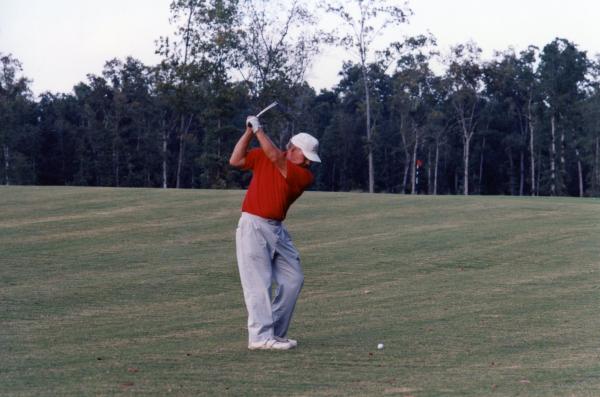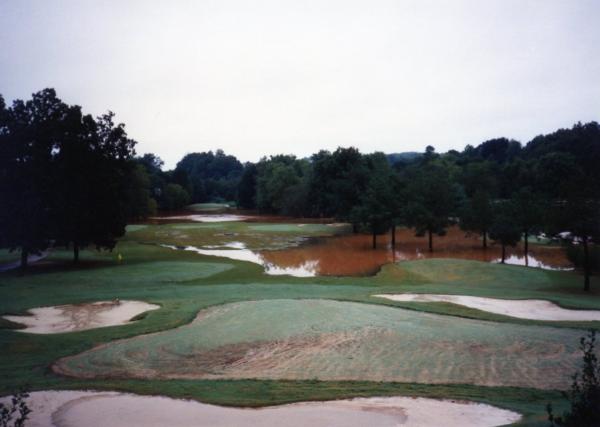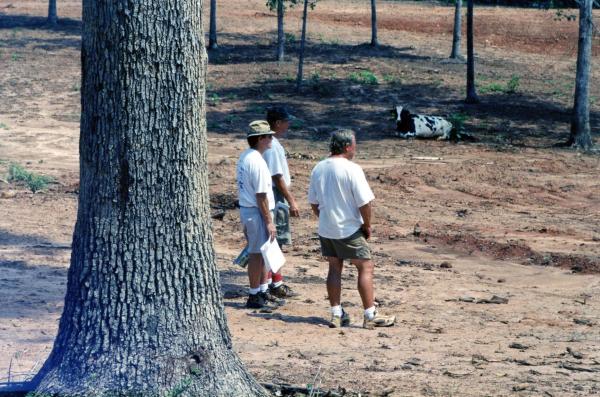Classic Golf Architecture and The Origins of Rockbottum CC
Due to a sudden increase in requests for more information on Rockbottum CC and Skeletal Greenkeeper Theory, I have decided to reveal how I became mired involved in this situation.
Note: I will not divulge the actual name of Rockbottum, because I do not wish to use TurfNet to promote my architectural brilliance, but if you are a sharp-eyed video enthusiast, you may already know the true name.
Obsessed with golf architecture from an early age, mostly due to the strategic and tactical nature of planning and placing golf shots for optimum effectiveness, I enjoyed playing golf most when I asked myself: What is the architect trying to tell me, what is he trying to make me do?
To me, that was the secret that unlocked how to play the hole. I learned this while looping for Dad at various pro events, both large and small. I was a miserable caddie, but a fairly observant architecture student, and the importance of strategic choice to the quality of the golf experience jumped right out at me.
I decided the value of a golf course was not based upon beauty, amazing conditions, length or exclusivity, but how fun the course was to play. If the course triggered in me a strong urge to return and play again, it was probably fun.
If the course was a death march, it was not fun, and I had no reason to come back for more masochistic brutality.

Over the years, Dad blended his golf skills with superintendent talent and fixed bad golf courses, in order to help the less skilled enjoy the game. He widened fairways, cut back rough, removed trees and installed inverted bunkers.
(Inverted Bunkers, also known as mounds, were easier to maintain, gave themselves to the ground game when positioned in front of greens and just looked better than washed out sand pits.)
Dad was frequently accused of softening the golf course, usually by insurance agents with a 30 handicap, so I probably don't need to go much farther with that.
When Televised Golf ushered in the era of Aesthetic Golf and that numbskull idea of opening one course every day for 20 years took hold, golf lost some of the fun. (Not just for the players, but for the folks doing the maintenance.)
We spent several years on a poorly constructed Dick Wilson course. It was probably Dick's last design as he died before completion and never actually set foot upon it. The builder went bankrupt and because his construction bond required the equipment remain on the course in the event of default, he buried all of it in a deep hole and fled.
 An insurance underwriter completed the course. He did fairly well, only reversing the blueprints on a couple of key holes; he made the landing areas the size of volleyball courts, hallway width. He left a number of deep ravines, fairway ditches and cliffs in-play, making some holes more dangerous than punching Ray Lewis in the back of the head.
An insurance underwriter completed the course. He did fairly well, only reversing the blueprints on a couple of key holes; he made the landing areas the size of volleyball courts, hallway width. He left a number of deep ravines, fairway ditches and cliffs in-play, making some holes more dangerous than punching Ray Lewis in the back of the head.
Dad fixed it. He widened landing areas, piped ditches, grew grass on places previously barren (greens, tees and fairways) and generally performed a miracle. The golf course soon became extremely popular, to the point where we couldn't get on our own golf course until after supper. Made me furious.
Dad made the course fun for the golfer, especially the golfer that paid the bills, not the low-handicap loudmouth or the mini-tour player that wanted everything for free.
Important lesson, right there, I don't care who you are.

Over the next couple of decades, I worked on really terrible real-estate bait courses, triggered by the One Course A Day mantra. I helped build really bad courses and worked behind really, really bad architects, especially those without any golf skill at all, just some mysterious birthright that allowed them to priss around telling us to put greens in swales before they jetted off to Europe.
Working on courses designed by these guys was like eating syrup of Ipecac for breakfast every day, so I went back to the Mom-and-Pop courses and munis, where I could inflict install my classic architecture ideas and make golf fun instead of the metaphysical equivalent of eating glass and awaiting the results.
After several years of Frankenstein type raising-the-dead experimentation on courses designed by numbskulls that couldn't finish a round of golf with a beer cooler full of golf balls, I was approached by a man asking if I could build a course with similar attributes.
"You mean really terrible design?" I asked.
"No," he shook his head, "really affordable and fun."
"Yes, Amen!" I said and took the job building Rockbottum CC.
It was a farm-to-golf conversion. I told the owners I would do it under two conditions: First, it was to be old-style, classic architecture with no houses along the fairways. They agreed to that, not because they had any idea what classic architecture was, as they were dairy farmers. They just liked the no houses idea.
Second, I wanted them to read a number of books on early golf architecture before we got started. It wasn't that I was evangelizing, I just wanted them as informed as possible when the armchair experts showed up later in the building process and tried to take over.
(Armchair experts tend to appear late in the building, re-designing or architectural adjustment process. Folks with no clue how to get started become geniuses when you near completion.)
By the time they finished ten or so books, I had a number of routings and we chose the one that would let the place operate as a dairy farm until the day we began to grass. That was a nightmare. I learned that cows are attracted to fresh dirt, like cats to catnip. Every time I hand cut a bunker, Cow 337 -- the leader of the bad cows -- would show up and cave in my edges, while testing the drain capacity.

I attempted to teach 337 not to whiz upon my work by hitting her in the skull with a shovel, but it was amazingly difficult, as she moved like Barry Sanders . . . juking, hopping backwards, head-faking and taunting me.
We moved almost no dirt. Not because I was trying to ingratiate myself with the Minimalism hipster doofus crowd, but because as a GCS, I knew what happens when you move lots of dirt. The drainage pattern is changed and doesn't recover for several decades.
Just before building, I went with Dad and my brother Mike to play Cuscowilla, a Coore and Crenshaw design not far from Rockbottum. There had been a 1" rain the night before and I was worried we would not get the firm and fast effect. But C&C had moved very little dirt and the course played dry. After a wonderful 18 holes on Cuscowilla, we went next door and death-marched played Great Waters, a Nicklaus course.

Great Waters, a course that raters love -- for some reason I will never understand -- was not great. It was sopping wet and miserable, especially in the saddle cuts and anyplace the shapers had moved mountains of dirt to help achieve some sort of Augusta National resemblance. If someone tells you massive dirt moving does not affect drainage, ask if he was ever a GCS . . . or had to hang around and fix stuff after the archie vanished in his chariot of fire.
It took three years to complete Rockbottum, at under a million dollars, land included. Lots of hand work and constant explanation of what we were trying to do resulted in my developing a fake Scottish accent, but we finished with fairway widths like The Old Course and massive rolling greens with very few bunkers.
I finished the project a confirmed cow hater, a bovine racist.
Probably the strongest aspect of Rockbottum is the $10 Green Fee for walkers, although no one walks anymore. But my favorite part of Rockbottum is the greens.
The greens are Ultra-Dwarf Bermuda, some of the first in the area. The greens are very firm and range from enormous, open and undulating to small, bunkered and sedate. To increase the fun factor on the greens, I utilized Dr. MacKenzie's rule for achieving subtle green contours:
"Hire the village idiot and tell him to make it flat."
I hired me. The place is eat up with subtle contours. The downside for me is the average $10 golfer doesn't know or appreciate the architectural efforts and the golfers that would appreciate it either don't come because of the lack of dress code and minimal conditioning -- or they do and just don't admit it.
But somebody keeps coming, cause I can't get on the course to play until after supper. Makes me furious.



0 Comments
Recommended Comments
There are no comments to display.